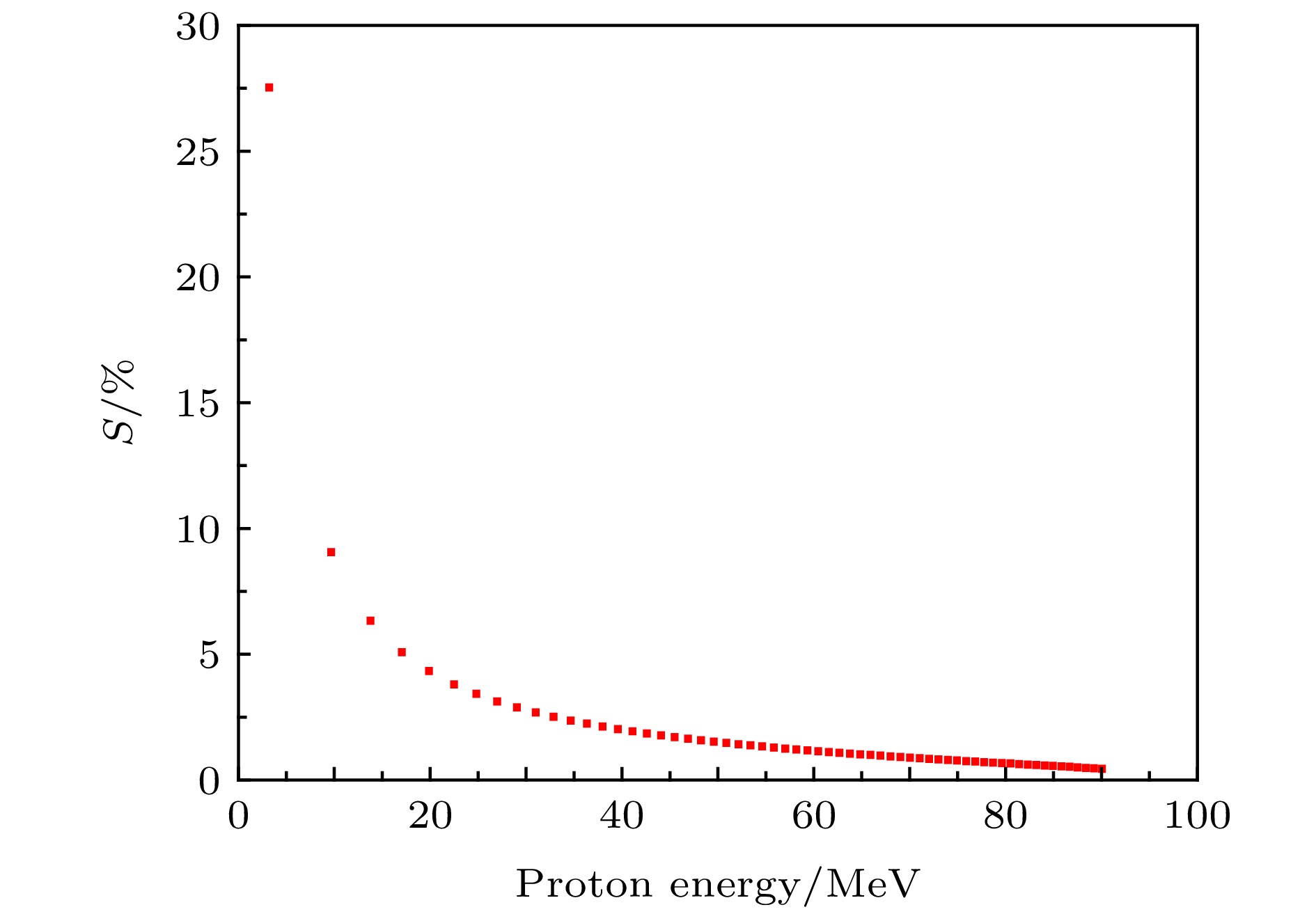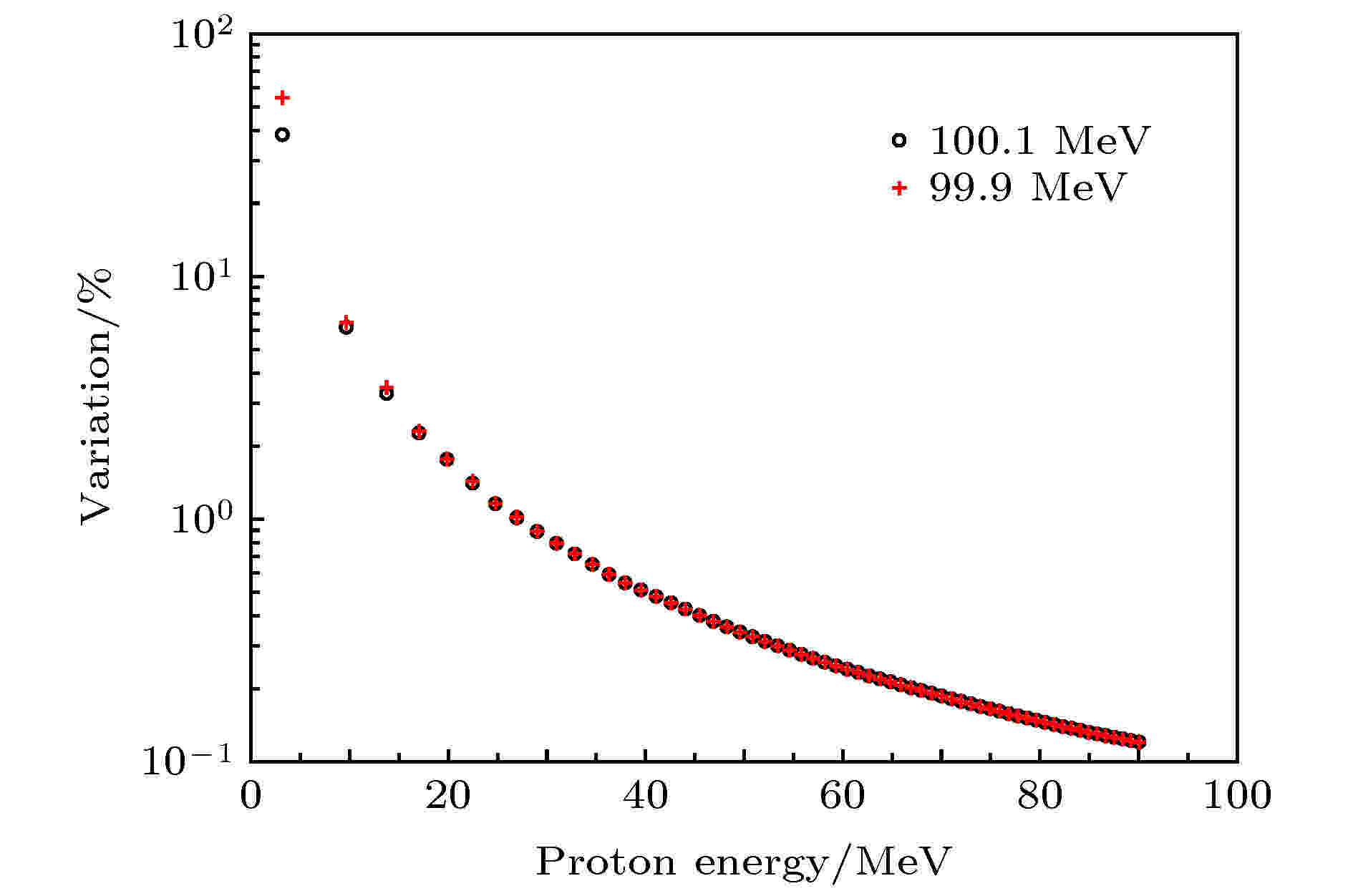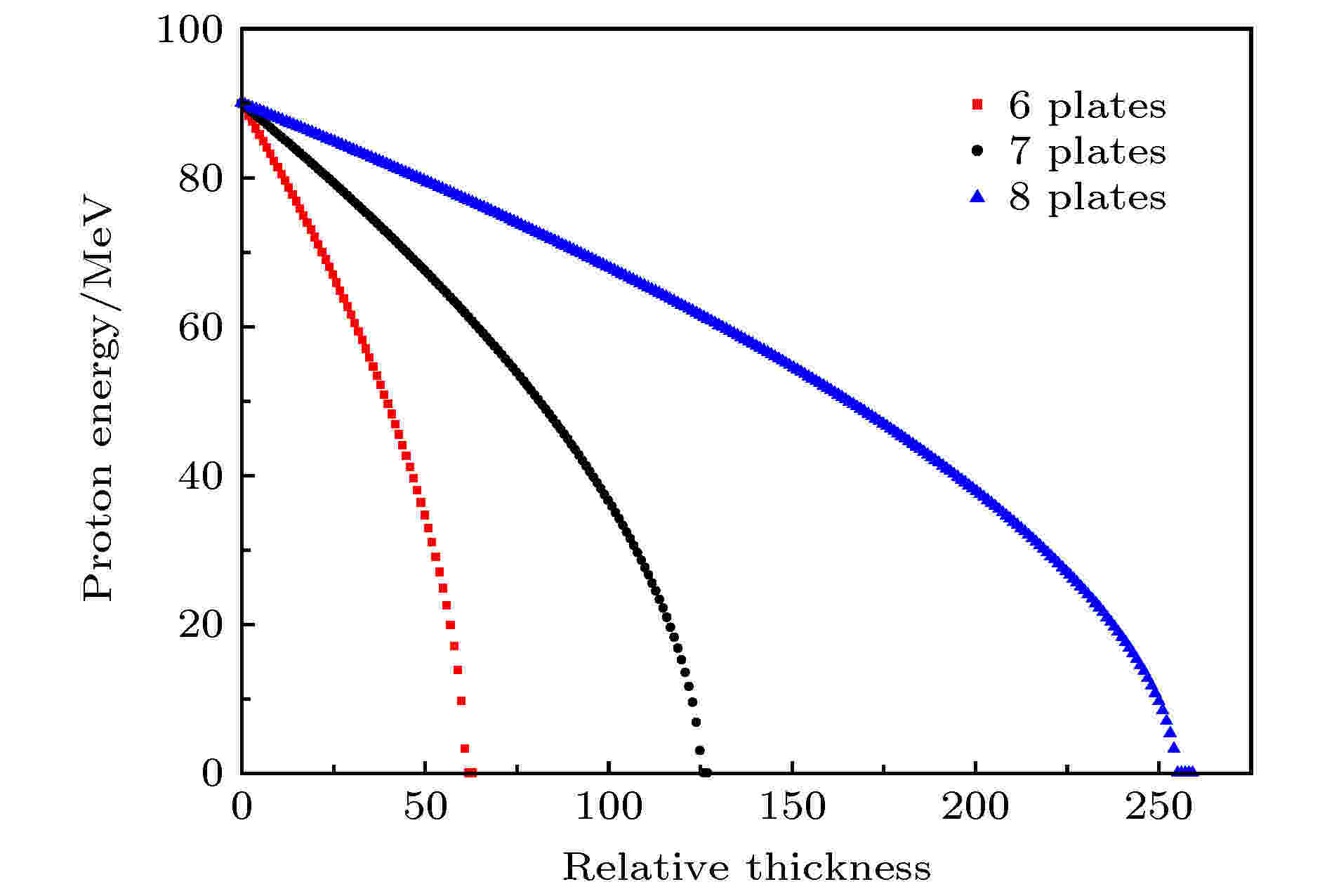全文HTML
--> --> -->在质子SEE的实验研究方面, 国内起步较晚, 且已开展的实验主要集中在低能区域, 相关的加速器有北京大学的EN串列加速器[5]、北京HI-13串列加速器[6]和中国科学院高能物理研究所的质子直线加速器[7]等, 这3台加速器可提供的质子的最高能量分别为10, 26, 35 MeV. 目前, 国内的中高能质子加速器较为缺乏, 已建成的仅有中国原子能科学研究院的100 MeV质子回旋加速器. 在该加速器上建设质子SEE试验装置, 不仅能够填补国内中能质子SEE试验的空白, 也能在一定程度上满足国内质子SEE考核试验的需求[8]. 鉴于该加速器直接提供的质子的能量为70—100 MeV, 采用降能器对质子进行降能是快速获得从低到高多个能点质子束流的简单易行的方法. 质子SEE实验的主要目的是获取微电子器件的质子SEE截面的能量依赖关系, 因此降能器对提升质子SEE实验的效率具有重要意义. 本文的降能器设计主要以利用加速器提供的100 MeV质子进行SEE实验为应用背景来展开.
降能器设计的核心在于降能片材料的选择, 以及降能片片数和厚度的设置. 参考PSI, 采用铝作为降能片材料. 在降能片数目方面, 考虑100 MeV比254 MeV低, 可初定为6片来进行设计. 各降能片厚度的设置是降能器设计的最关键之处. 由于每个降能片均有使用、不使用两种状态, 故理想情况下应实现26 = 64种不同组合, 每种组合对应的降能片厚度之和应该不同, 这样就可将质子降到64种不同的能量, 以最大程度上满足质子SEE实验对多能点质子束流的需要. 如果能够先给出这64种质子能量, 然后去确定6片降能片的厚度, 这种情况是比较理想的. 但是, 实际上这相当于6个变量同时满足64个方程, 这个方程组一般是不可解的. 因此, 只能从相反的角度考虑, 先给出6片降能片的厚度, 然后观察相应的64种质子能量是否满足设计要求.
首先, 考虑一个数学问题. 从1, 2, 4三个数字中任选一个或多个数字取其和可得到7个数字: 1, 2, 1 + 2, 4, 1 + 4, 2 + 4, 1 + 2 + 4, 即从1到7之间的连续整数. 同理, 由1, 2, 4, 8, 16, 32六个数字可得到从1到63之间的连续整数. 因此, 若将6个降能片的厚度之比设定为1∶2∶4∶8∶16∶32, 则相应63种组合对应的降能片厚度之和构成等差数列, 其首项和步长均为第1片降能片的厚度(记为a), 算上6个降能片均不使用的情况, 共64种完全不同的组合方式, 从而最大化地实现了6个降能片的作用. 将某一种组合的降能片的厚度之和与a的比值记为tR, 称其为相对厚度, 则tR为0到63之间的整数. 假定质子在到达降能器之前能量为E, 其在铝中的射程为R, 则可令a = R/63, 即使用全部降能片时恰好能将质子完全阻止. 显然, 这种设计能够使该降能器产生0到E之间的64个能点的质子束流.
质子SEE实验一般要求质子束流的均匀性在70%以上, 为满足此要求, 在加速器提供的质子束流到达降能器之前利用双环双散射体法对其进行扩束及均匀化[10], 使用的双散射靶也不可避免地产生一定的降能作用, 在降能效果上相当于1.54 mm的钽. 对于加速器直接提供的100 MeV质子而言, 质子通过双散射靶后能量会降低到90.07 MeV. 由于90.07 MeV的质子在铝中的射程为30.59 mm, 故a = 30.59/63 = 0.49 mm. 不妨取a = 0.5 mm, 从而6片降能片的厚度依次为0.5, 1.0, 2.0, 4.0, 8.0, 16.0 mm.
3.1.降能效果
要计算穿过降能器之后质子的能量, 需要知道质子在铝中的能量-射程关系, 见图1. 能量为E、在铝中射程为R的质子, 在经过总厚度为ti的降能片组合之后, 其剩余能量记为Ei, 则Ei对应的在铝中的射程应为
 图 1 采用SRIM计算得到的1?100 MeV质子在铝中的阻止本领及射程
图 1 采用SRIM计算得到的1?100 MeV质子在铝中的阻止本领及射程Figure1. Stopping power and range of 1?100 MeV protons in aluminum calculated by SRIM.
 图 2 入射质子穿过64种不同降能片组合之后的能量
图 2 入射质子穿过64种不同降能片组合之后的能量Figure2. Residual energies of the incident protons after they pass through the energy degrader with 64 kinds of combinations of 6 energy degrader plates.
由图2可知, 相对厚度tR在0—60区间时, 可获得9.69—90.07 MeV范围内的61个质子能点, 各能点之间的间隔在0.84—4.09 MeV之间. 在该能量范围内, 阻止本领随着质子能量减小而增加, 从而使得这61个质子能点之间的间隔随着tR的增大而增大. tR = 61时, 出射质子能量为3.21 MeV, 此时降能器引起的能量岐离、角度岐离以及加速器直接引出的质子能量的精度误差均较大, 参见后面的讨论. tR = 62, 63时, 降能器可将90.07 MeV的质子全部阻止. 进行质子SEE实验时, 质子与降能材料发生核反应产生的中子本底是不可避免的, 而此时产生的中子本底应该是最多的, 故可在此保守情况下估计中子本底对质子SEE实验产生的影响, 这也是设计降能器时使a值稍大的一个目的.
相对厚度tR除了能够表示使用的降能片的总厚度之外, 还能够表示使用降能器产生的质子能点的次序以及降能器的状态或操作. 以tR = 41为例, 降能片的总厚度为41 × 0.5 = 20.5 mm. 按图2中所示的质子能点由高到低排列, 以不使用降能器时产生的90.07 MeV为第0个能点, 以仅使用第一片降能片时产生的89.23 MeV为第1个能点, 依次类推, 则tR = 41时产生的质子能点48.26 MeV在上述一系列能点中为第41个. 41 = 1 + 8 + 32, 即使用的是第1, 4, 6片降能片. 41的二进制写法为101001, 若以1代表使用, 以0代表不使用, 最低位到最高位依次代表第1片到第6片, 则101001正好可以代表6片降能片的状态, 也就是降能器的相应操作, 这样就方便了我们对降能器的远程控制.
2
3.2.能量岐离
带电粒子在物质中与靶核及其核外电子发生多次碰撞而损失能量, 由于其经受的碰撞次数、每次碰撞所转移的能量都是随机变化的, 这种碰撞过程的统计涨落引起粒子在穿过靶物质后产生能量岐离现象. 对本文所涉及的在快速能区的质子而言, 能量岐离主要是由于质子与靶原子的核外电子相互作用而产生. 根据Bohr理论, 这种能量岐离可用高斯分布来描述, 相应的均方差参数为以

 图 3 质子经过降能器产生的各能点质子的能量岐离程度
图 3 质子经过降能器产生的各能点质子的能量岐离程度Figure3. Energy straggling degree of the resulting protons at each energy point produced by the energy degrader.
2
3.3.角度岐离
单个入射粒子在靶物质中与靶核碰撞会产生小角度偏转, 而与靶原子的核外电子碰撞引起的偏转可以忽略, 经多次碰撞之后, 粒子会偏离原来的运动方向. 一束具有相同入射方向的带电粒子, 在靶物质中穿过厚度t之后, 粒子偏转角度在小散射角内满足高斯分布, 该高斯分布的半高宽







要详细了解进行质子SEE实验时DUT (device under test)位置处的束流横向分布情况, 需对质子SEE实验装置中的双散射靶、降能器、DUT以及所涉及的空间几何关系进行全面考虑. 为方便起见, 本文仅考虑降能器的影响, 且忽略各降能片之间实际存在的间隙, 在此情况下对质子束流在降能器中产生的角度岐离进行粗略的估计, 图4给出了通过(2)式计算得到的经降能器产生的各能点质子的角度歧离情况. 当tR = 61时, 质子剩余能量为3.21 MeV, 此时质子角度岐离最大,



 图 4 经过降能器产生的各能点质子的散射角半高宽
图 4 经过降能器产生的各能点质子的散射角半高宽Figure4. Full width at half maximum of the scattering angle of the resulting protons at each energy point produced by the energy degrader.
2
3.4.初始质子能量精度的影响
加速器直接引出的初始质子能量可能存在一定偏差, 假定引出100 MeV质子时偏差为0.1%, 探讨此时质子经降能器不同状态后剩余能量Ei的变化, 结果见图5. 可见, 质子经过降能器后的能量越低其偏差就越大. 以加速器引出100.1 MeV质子为例, 与引出100 MeV质子情况相比, 当tR = 1时, 经过降能器之后质子能量Ei由89.22 MeV提高0.11 MeV, 即0.12%; 当tR= 61时, Ei由3.21 MeV提高1.23 MeV, 即38.35%. 造成这种结果的原因是质子的阻止本领随着能量的降低而增高(见图1), 因此对同样厚度的铝而言, 质子能量越低, 在其中所损失的能量就越大. 如100 MeV质子在64.5 μm厚的铝内损失能量约为0.1 MeV, 而2.62 MeV的质子恰好在其中损失全部能量. 也正是由于同样的原因, 99.9 MeV情况造成的质子能量偏差要稍大于100.1 MeV情况. 类似地, 可以推测, Ei的能量越低, 铝片的加工精度、SRIM计算结果的精度给其带来的误差也就越大. 图 5 加速器直接提供的质子能量偏差0.1 MeV时造成质子经过降能器后剩余能量的偏差情况
图 5 加速器直接提供的质子能量偏差0.1 MeV时造成质子经过降能器后剩余能量的偏差情况Figure5. Variation of the residual energy after the protons with the energy deviation of 0.1 MeV directly provided by the accelerator pass through the energy degrader.
2
3.5.对70—100 MeV质子的适用性
加速器可直接提供70—100 MeV的质子, 故对所设计的降能器对其提供100, 90, 80, 70 MeV四种能量质子情况下的降能效果进行了考察. 双散射靶的存在使得四种情况下的质子能量分别降为90.07, 79.12, 68.15, 56.70 MeV, 使用降能器可提供的质子的最低能量分别为3.21, 6.75, 4.59, 8.29 MeV, 提供的各质子能点的最大间隔分别为6.48, 4.92, 5.78, 4.44 MeV, 在降能器状态tR分别为62, 49, 38, 27时即可将质子全部阻止, 如图6所示. 可见, 该降能器不仅适用于100 MeV质子, 对于加速器直接提供的70—100 MeV范围内的质子也都是基本适用的. 另外, 使用能量低的质子比使用能量高的质子经降能器降到同样的能量时所使用的降能片的总厚度小, 显然产生的能量岐离和角度岐离也小. 如100 MeV质子在tR = 40时能量降为49.58 MeV, 表征能量岐离的均方差参数σ为0.75 MeV, 散射角半高全宽



 图 6 降能器对加速器直接提供的100, 90, 80, 70 MeV 四种能量质子的降能效果
图 6 降能器对加速器直接提供的100, 90, 80, 70 MeV 四种能量质子的降能效果Figure6. Effects of the energy degrader for the protons at 100, 90, 80 and 70 MeV directly provided by the accelerator.
 图 7 降能器使用6, 7, 8片降能片时的降能效果
图 7 降能器使用6, 7, 8片降能片时的降能效果Figure7. Effects of the energy degrader using 6, 7 and 8 aluminum plates, respectively.
考虑降能器之前的双散射靶, 该降能器能够产生9.69—90.07 MeV范围内的61个质子能点, 这些能点之间的间隔在0.84—4.09 MeV之间, 且能量岐离均在9.06%以下, 角度岐离在44.79 mrad (2.57°)以下, 基本可满足质子SEE实验的要求. 降能器产生的质子能量越低, 其带来的能量岐离和角度岐离也就越大, 对加速器直接引出的质子能量精度的影响也就越大. 降能器产生的角度岐离将使得质子束流在横向上产生一定的扩展, 从而使质子注量率有所降低. 该降能器产生的质子最低能量为3.21 MeV, 其能散约为28%, 且加速器提供的初始质子能量的微小变动对其影响很大, 100 MeV质子能量上下变动0.1%使其产生的变化分别约为38%和55%. 由于3 MeV左右对很多微电子器件而言是质子SEE截面刚出现或快速上升的区域, 故当其应用于质子SEE实验时应对其能散及可能的误差有明确的认识. 经计算, 该降能器不仅适用于100 MeV质子, 对加速器直接提供的70— 100 MeV能区的质子也是适用的. 若要通过降能器获得更加连续化的质子能点, 可按该设计方法增加降能片的片数来实现, 另外, 本文对7片、8片降能片情况进行了讨论. 最后, 本文提出的二进制降能器设计方法简单有效, 对于实现多能点快速降能的降能器的设计具有较强的借鉴价值.
